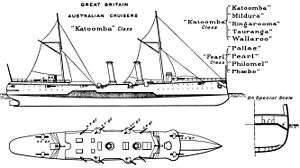Pearl-class cruiser
 HMS Tauranga in Tasmania circa. 1902 | |
| Class overview | |
|---|---|
| Name: | Pearl |
| Operators: | |
| Preceded by: | Barham class |
| Succeeded by: | Apollo class |
| In commission: | 1890 - 1947 |
| Completed: | 9 |
| Active: | none |
| General characteristics | |
| Type: | Third-class cruiser |
| Displacement: | 2,575 tons |
| Length: | |
| Beam: | 41 ft (12.5 m)[1] |
| Draught: | 15 ft 6 in (4.72 m) |
| Installed power: | 7,500 ihp on forced draught |
| Propulsion: |
|
| Speed: | 19 kn (35 km/h; 22 mph) |
| Complement: | 217 |
| Armament: |
|
The Pearl-class cruiser was a class of nine third-class cruisers designed by Sir William White, five of which were paid for by Australia under the terms of the Imperial Defence Act of 1887 to serve in Australian waters.
Design
Pearl-class ships displaced 2,575 tons and were capable of 19 knots (35.2 km/h).

Ships
| Name | Launched | Fate |
|---|---|---|
| Pallas | 1890 | Sold for scrap in 1906. |
| Pandora | 1889 | Renamed HMS Katoomba. Sold for scrap in 1906. |
| Pearl | 1890 | Sold for scrap in 1906. |
| Pelorus | 1889 | Renamed HMS Mildura. Sold for scrap in 1906. |
| Persian | 1890 | Renamed HMS Wallaroo and then HMS Wallington. Changed back to original in 1920 before being sold for scrap. |
| Philomel | 1890 | Transferred to New Zealand Navy in 1914. Sold on 17 January 1947. Scuttled 6 August 1949. |
| Phoebe | 1890 | Sold for scrap in 1906. |
| Phoenix | 1889 | Renamed HMS Tauranga. Sold for scrap in 1906. |
| Psyche | 1889 | Renamed HMS Ringarooma. Sold for scrap in 1906. |
References
- Winfield, Rif & Lyon, David (2004). The Sail and Steam Navy List: All the Ships of the Royal Navy 1815–1889. London: Chatham Publishing. ISBN 978-1-86176-032-6. OCLC 52620555.
- Battleships-cruisers.co.uk: Pearl-class
External links
| Wikimedia Commons has media related to Pearl class cruiser. |
This article is issued from Wikipedia - version of the 12/25/2015. The text is available under the Creative Commons Attribution/Share Alike but additional terms may apply for the media files.